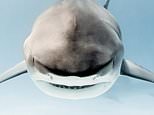
Following a 1997 shark attack, Hawaiian photographer Mike Coots (above) devoted his life to shark conservation
When Mike Coots was 18, he was attacked by a tiger shark while bodyboarding with friends in Hawaii.
He lost his right leg, at the calf, in the attack and suffered such extensive blood loss that doctors said he should have died.
But in the years that followed the ordeal, rather than exacting revenge on the species or refusing to set foot in the water again, he went down an entirely different path.
Coots, now aged 44, became deeply fascinated by sharks and devoted his life to photographing them – with mesmerising results. His work enormously benefits both sharks and humans, helping the world to better understand these oft-misunderstood apex predators.
The conservationist is showcasing his spectacular shark photography in a new book, Shark: Portraits (published by Rizzoli), in a bid to illustrate how sharks ‘can be beautiful and are much needed as an apex predator for the health of our oceans’, he tells MailOnline Travel.
Coots’ shark attack occurred in 1997 when he went out to ‘catch some waves’ early one morning in his native Kauai. He recalls: ‘I paddled for a wave, and a large tiger shark attacked me. I felt no pain, just a lot of pressure.’ Reflecting on why he was attacked, he says: ‘It [was] the time of year when more attacks happen, and the water was murky.’ He notes that the shark ‘probably mistook [him] for a turtle’.
Thankfully, Coots managed to punch the shark in the nose and it let go of him. He made it to the beach, where his friend applied a tourniquet that saved his life.
At the time, Coots thought he ‘was going to die, but it wasn’t scary’, he says, adding that he went into shock on the way to the hospital. ‘I woke up the next day post-surgery happy to be alive,’ he says.
Coots has compiled his magnificent shark photography into a new book, Shark: Portraits. Above is one of the images from the photobook, showing a great white shark named Buckethead off the coast of Mexico’s Guadalupe Island
LEFT: In this powerful shot by Coots, a female tiger shark named Emily is seen floating towards the camera at the Tiger Beach dive site in the Bahamas. RIGHT: Named after the world-renowned St. Lawrence String Quartet violinist, Geoff Nuttall is a male great white shark. In this spectacular shot by Coots, he can be seen in waters near Mexico’s Guadalupe Island
He went on to study photography in college, cutting his teeth in the craft by shooting models and professional surfers. It was after his graduation that he started to develop a passion for shark conservation.
A lightning bolt moment came when he was invited on a shark-diving trip and brought a camera along with him. ‘After that, [sharks] became my favourite subject to photograph,’ says Coots, adding that sharks ‘are beautiful, mysterious, technically difficult as a subject and really fun to photograph’.
Over the past two decades, he has built up a network with fellow conservationists, with whom he visits shark-populated diving spots everywhere from Mexico to New Zealand.
A female great hammerhead shark named Pocahontas (also known as Patches) is shown at the Tiger Beach dive site in the Bahamas in this striking picture
LEFT: Coots photographing a tiger shark at the Tiger Beach dive site in the Bahamas. RIGHT: A great white shark nears the water’s surface off the coast of Motunui, also known as Edwards Island, in New Zealand
This stunning shot shows a great white shark by Motunui, also known as Edwards Island, in New Zealand
But it’s not always easy to track the creatures down. In fact, the biggest challenge Coots faces is finding sharks to photograph. He says: ‘They are not as common as people think, and you sometimes have to go to the edge of the earth to find certain species.’
In his career, Coots has documented everything from hammerhead sharks to tiger sharks. The largest creature he has ever shot is a 12ft (3.6m) mature female great white shark, he reveals.
He’s within inches of the sharks when he’s photographing them, whether he’s free-diving, scuba diving or in a shark cage.
Naturally, safety precautions are taken when shooting underwater. Coots says: ‘The safest way to be underwater with sharks is to have clear visibility and lots of eye contact with sharks. They are ambush predators and if they know you know they are there, it’s much safer.’
Coots explains that they’re more likely to attack if you’re in ‘murky water’ or ‘splashing and looking like an injured animal’. He warns: ‘Don’t splash, panic, and if underwater always look at the shark and make yourself seem large… don’t turn your back on a shark.’
Inexperienced photographers can make mistakes when photographing the sharks too, he reveals. Coots says: ‘They get caught up in looking through the camera viewfinder too much and are unaware of what’s happening around them, especially if there are multiple sharks in the area.’
Johnny Rainbow, a male great white shark, is captured in this magnificent close-up shot, taken by Mexico’s Guadalupe Island. On his head, bite marks from another shark are visible
Shark: Portraits by Mike Coots, published by Rizzoli, is on sale now for £49 ($60). The cover image shows a great white shark by Guadalupe Island in Mexico
A hair-raising situation once enveloped Coots himself while underwater with a great white shark. He reflects: ‘It came close to biting me, but I think it was just being territorial and wasn’t hungry, otherwise, if it wanted to, it would have [bitten me]. I had so much adrenaline, and I had a hard time even talking a few hours after.’
It’s important to know the warning signs when sharks are preparing to attack. Coots says: ‘They will drop their pectoral fins and arch their body and swim erratically.’
But despite what some may think, sharks aren’t intent on hunting humans, Coots notes, explaining that the biggest misconception about these creatures is ‘that a shark wants to bite you as soon as you enter the water’. ‘That’s the furthest from the truth,’ he admits.
Coots thinks that humans’ misguided fear of sharks is largely a response to their representation in Hollywood – with films such as the 1974 blockbuster Jaws – and the media. Their physical traits also inspire terror, he notes, saying: ‘They are also large, powerful, and have sharp teeth… it’s almost like a dinosaur that didn’t go extinct.’
The biggest positive to his work, he reveals, is getting ‘to share compelling, authentic images to those who love sharks, and to those who are unfamiliar with them, showcase a new side [to sharks]’. He hopes that this new book demonstrates how ‘sharks are misunderstood, gorgeous as a subject and needed in our seas for a healthy planet’.
Shark: Portraits by Mike Coots, published by Rizzoli, is on sale now for £49 ($60).
Source link
CHECK OUT: Top Travel Destinations
READ MORE: Travel News



